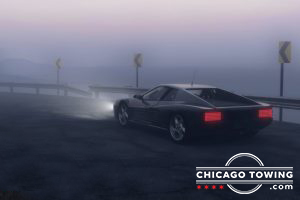In this blog entry, the Chicago roadside assistance service and Chicago area towing experts here at Chicago Towing will detail some essential tips for driving safe on a rainy day.
Quick Car Equipment Check
Check your car’s equipment including headlights, taillights, windshield wipers, and horn to make sure that they are working. Ensure that your car’s tire treads are adequately intact – as worn down tires make slippery roads more likely to cause your car to hydroplane and skid.
Drive Slow
Make sure to drive much slower on wet roads as your car’s reaction time will be somewhat diminished. This is an absolute must in rainy weather. Only by slowing down can you provide your car more time to react to obstructions, accidents, or hydroplaning.
Headlights
Always keep your headlights fully on when driving in the rain – even if it’s only a light rain or mist.
Windshield Wipers
Always turn your windshield wipers on – also, even only in light rain or mist. Windshield wiper speed can be adjusted to remove moisture from your windshield. We recommend also possibly spraying or wiping special rain resistant products onto your windshield – and replacing your wiper if you hear them scraping on your windshield.
Distance Between Cars
Make sure to drive at least a car’s length behind each car for every 10 MPH you are driving – and when it’s raining, give even more distance than this!
Avoid Puddles
Hydroplaning is more likely to occur when driving through standing water or large puddles. This phenomenon is when a car glides over water preventing your tires traction from touching the road – which can cause skidding or cause your car to go out of control. Drive around standing water by steering or safely changing lanes – and if your car starts to hydroplane, slowly take your foot off the accelerator and steer in the direction that the front of your vehicle needs to turn (rather than the other direction.) Never make a sudden turn or slam on your brakes!
Ventilation
Rain increases humidity, and your vehicle’s windows can easily fog up. Make sure to ventilate your vehicle to remove the fog – and crack a window if need be. If you still can’t see, safely pull your vehicle to the side of the road away from other vehicles until you can easily see through your windshield.

